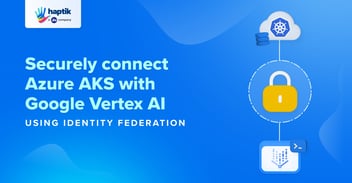Scaling HAProxy on AKS for Billions of Transactions with Dynamic Autoscaling and Token Management

At our scale, we needed to handle billions of transactions efficiently - routing across multiple environments and internal data centers - while maintaining reliability, security, and dynamic control. To achieve this, we chose HAProxy, a proven, high-performance load balancer known for its lightweight footprint, flexibility, and ability to handle massive concurrency with minimal overhead.
This blog walks you through how we deployed HAProxy in high-availability (HA) mode on Azure Kubernetes Service (AKS) -complete with autoscaling powered by KEDA, seamless integration with Azure Application Gateway, and dynamic token management using Azure File Share, all designed to deliver scalable, self-hosted traffic routing at enterprise scale.
ALSO READ: How We Took Our Kubernetes Autoscaling from Basic to Advanced Mode with Istio Metrics
The Challenge: Scaling HAProxy for Real-World Production Complexities
When running HAProxy on Kubernetes in a production-grade setup, we often face three major challenges:
Scalability
Handling spikes in request traffic without manual intervention.
Dynamic Configuration
Being able to update token or authentication files (used for request validation) dynamically, without restarting or redeploying HAProxy pods.
Integration with Azure Networking
Running HAProxy behind Azure Application Gateway (App Gateway) while maintaining performance, visibility, and security.
Our goal was to create an auto-scaling, token-aware, and persistent HAProxy setup that integrates seamlessly with Azure Application Gateway and KEDA.
Solution Overview
.png?width=8130&height=2726&name=haproxy_aks%20(1).png)
Here’s how the setup looks at a high level:
- HAProxy runs in HA mode on an AKS cluster.
- Application Gateway sits in front, handling SSL termination and forwarding traffic to HAProxy.
- KEDA monitors request counts (via App Gateway metrics) and auto-scales HAProxy pods accordingly.
- Azure File Share provides persistent storage for token files, allowing dynamic updates without redeployment.
Step-By-Step Implementation
1. Create an AKS Cluster with Autoscaling
- Create an AKS cluster with autoscaling enabled.
- Assign system-managed identity of the cluster
ReaderandNetwork Contributorroles to the resource group where the VNet/subnet resides.
Create a Service Principal (SP) with Monitoring Reader role for App Gateway metrics.
2. Prepare the Kubernetes Environment
Login to your cluster and set up a namespace for HAProxy:
kubectl create ns haproxykubectl config set-context --current --namespace=haproxy
3. Configure Persistent Storage for Token Files
We’ll store token-ID pairs in Azure File Share so they persist even if HAProxy pods restart.
Create the Azure File Share
1. Create a Storage Account and a File Share named haproxy-allowed-ids with a 2 GB quota.
Mount it on your build server:
sudo mkdir -p /mnt/azurefiles/allowed_idssudo mount -t cifs //yourstorageaccount.file.core.windows.net/allowed-ids-share /mnt/azurefiles/allowed_ids \-o vers=3.0,username=yourstorageaccount,password=yourstoragekey,dir_mode=0777,file_mode=0777,serverino
2. Clone the git repo and run arrange_files.sh script
git clone https://gist.github.com/108f3c3444180d9d4a95d3ac7d8dc338.git haproxy_repocd haproxy_repobash arrange_files.sh
3. Base64 encode your storage credentials:
echo -n "KEY" | base64
4. Add them to fileshare/azure_storage_secret.yaml and apply:
kubectl apply -f fileshare/azure_storage_secret.yamlkubectl apply -f fileshare/pv.yamlkubectl apply -f fileshare/pvc.yaml
4. Create Token Files Dynamically
Inside the mounted directory:
cd /mnt/azurefiles/allowed_idsecho "Client-ID" >> token_value.txt
This token file is now automatically visible to all HAProxy pods (thanks to the Azure File Share mount).
5. Deploy HAProxy with Helm
Create a secret for the thirdparty-api-auth token:
kubectl create secret generic thirdparty-api-auth-token-secret \--from-literal=token="<THIRDPARTY_API_AUTH_TOKEN>"
1. Deploy HAProxy:
helm install haproxy haproxy
2. Verify pod logs and ensure token files are mounted:
kubectl logs <haproxy-pod-name>kubectl exec -it <haproxy-pod-name> -- ls /etc/haproxy/allowed_ids
6. Integrate KEDA for Autoscaling
KEDA will monitor App Gateway metrics (like request count) and automatically adjust HAProxy replicas.
Encode Service Principal credentials:
echo -n "CLIENTID" | base64echo -n "CLIENTSECRET" | base64
1. Set them in:
kubectl apply -f keda/monitor_secret.yamlkubectl apply -f keda/az_monitor_triggerauth.yaml
2. Update keda.yaml with:
- Application Gateway Resource URI
- Tenant ID
- Subscription ID
- Resource Group Name
Apply:
kubectl apply -f keda/keda.yaml
7. Configure Azure Application Gateway
Create the following components:
- Listener on port 443 (with SSL certificate)
- Backend pool → HAProxy service external IP
- Backend settings on port 80
- Health probe that returns 200 OK
Example health endpoint:
https://<haproxy-lb-ip>/health
Finally, map your DNS record to the App Gateway frontend IP.
Example validation call:
curl --location 'https://abc.example.com/wcc/1234567890/message_templates' \--header 'Content-Type: application/json' \--header 'Authorization: AUTHTOKEN' \--header 'Client-ID: SECRET
HAProxy Configuration Highlights
Below are key parts of the HAProxy configuration enabling dynamic token validation and routing.
globallog stdout format raw daemonmaxconn 50000lua-load /etc/haproxy/validate_token_id.lualua-load /etc/haproxy/read_token.luanbthread 4daemondefaultsmode httpoption httplogtimeout connect 5000timeout client 50000timeout server 50000frontend http_frontbind *:8080http-request set-var(txn.token) req.fhdr(Authorization)http-request set-var(txn.id) req.fhdr(Client-ID)http-request set-var(txn.is_token_valid) lua.validate_tokenhttp-request set-var(txn.is_id_valid) lua.validate_id_for_tokenuse_backend health_check_backend if { path_beg /health }use_backend token_backend if { path /api/token } { var(txn.is_id_valid) -m str true }use_backend backend-wa if { var(txn.is_token_valid) -m str true } { var(txn.is_id_valid) -m str true }backend health_check_backendmode httphttp-request return status 200 content-type "text/plain" string "OK"
Key Benefits of This Setup
| Feature | Description |
| HA Mode HAProxy | Ensures redundancy and high availability. |
| KEDA Autoscaling | Automatically scales HAProxy pods based on live traffic metrics. |
| Azure App Gateway Integration | Handles SSL termination, WAF, and provides unified ingress. |
| Dynamic Token Management | Tokens stored in Azure File Share can be added/updated instantly without redeployment. |
| Persistent Storage | Tokens and config persist even across pod restarts or scaling events. |
Conclusion
With this setup, HAProxy becomes a highly available, auto-scaling, and dynamically configurable API gateway layer for your applications on AKS.
By leveraging Azure Application Gateway, KEDA, and Azure Files, we get:
- Scalable performance,
- Zero-downtime token updates, and
- Seamless integration into Azure’s cloud-native ecosystem.
This architecture forms a robust foundation for secure, scalable, and maintainable ingress control in any enterprise Kubernetes environment.




